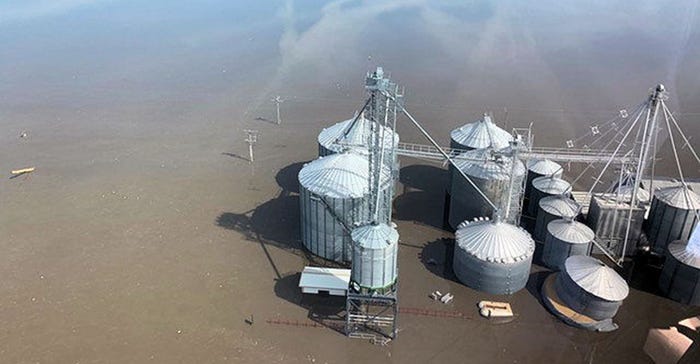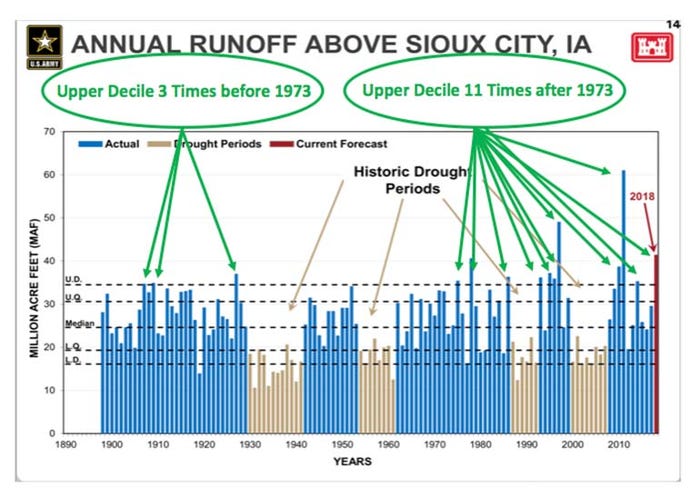May 10, 2019

By Tom Waters
The flood of 2019 wreaked havoc in the western corn belt. The Bomb Cyclone which brought heavy snow and rain happened so quickly it did not allow time for thousands of farmers to move grain, equipment, property and belongings out of harms way.
As we described in part one of this series, a river system that was originally designed for navigation and flood control has now been weakened by increasing numbers of experiments related to the Endangered Species Act.
In fact, failed experiment after failed experiment over the past 20-plus years has substantially changed the previously highly engineered river. Structures which once provided a stable channel have been weakened, and in some cases removed. Side channels and chutes have been opened to allow the River to flow uncontrolled and cause erosion and scouring.
Flood control has been diminished and riverboat pilots find it hard to navigate the channel, which has become dangerous at many locations. A system once used to provide flood control is now being use as a super-sized science experiment for two birds and a fish. As a result, we are seeing greater floods more often, human lives have been lost and people are enduring great suffering.
All the while, no scientific evidence can be found to show any of the changes have even helped the fish and two birds!
The U..S Army Corps of Engineers has spent over $748 million making changes to the River since 2005, in the name of Missouri River Fish and Wildlife Recovery. Meanwhile, more water enters the River at higher velocities. Note the Graph below from the Corps of Engineers:

Prior to 1973, the runoff above Sioux City reached the upper decile level only three times, while since 1973, runoff has been in the upper decile 11 times. Clearly, more water is coming into the system, more often.
Making changes to the system
What changes should be made to avoid tragedies like the one suffered last month? The flood of 2019 can more accurately be described as the flood of 1973 through 2019. Dike notching began in 1973, the first of many changes to the original river design. In 2004 congress approved changes to the Missouri River Master Water Control Manual which no longer held flood control as the primary purpose for the flood control system.
Instead, the Corps is forced to try to balance all the purposes of the system to the determent of their ability to provide flood protection.
When one uses something in a way it was not designed to be used, it often fails. When hooking a tractor to a plow too large for the tractor, the tractor may pull it for a short time, but eventually the tractor will give out and likely ruin the engine. Trying to put a gallon of water into a quart jar only causes a mess on the table top. Likewise, using the flood control system for science experiments is failing and making a mess of the Missouri River Basin.
Many want to blame the Army Corps of Engineers for the recent flooding and floods of the past. But the Corps is only following orders. We must understand where the orders to conduct science experiments with the Missouri River flood control system came from.
Ultimately, the Corps of Engineers’ orders come from Congress. Pressure from well-funded environmental groups, over the years, has caused Congress to blindly make changes in the way the Missouri River system is operated and removed flood control as the system’s top priority.
Making flood control the top priority
Flood Control MUST be returned as the top priority for the Missouri River basin. Flood control was the original purpose for building the system back in 1944; in my opinion flood control is now even more needed today than it was in 1944.
Think about the urban development that has taken place since those days. Water has fewer places to go today compared to 70 years ago. Inflows into the system are greater now and the system has not been improved to meet the challenges of higher flows and greater velocities. We’ve reached a tipping point, and people and property have suffered as a result.
Related: Missouri Governor Michael Parson on flood control
By making flood control again the top priority for the management of the system, infrastructure improvements can be made and flooding can be reduced -- even eliminated. We cannot build an umbrella over the coastlines to protect people from hurricanes, and we cannot bolt together the fault lines to protect people from earthquakes, but we can build flood control infrastructure to protect people and property from flooding. They do it in Holland and China, and we can do it here in the United States.
The key is for Congress to make flood control the priority.
It would be easy for Congress. Following flood after flood along the Missouri River, congress has spent millions upon millions of dollars for recovery. We suggest Congress should spend money up front to prevent the damages in the first place. Improving infrastructure now can reduce or eliminate the expense of recovery later.
Tom Waters is Chairman of the Missouri Levee and Drainage District Association. He operates his family farming business in the Missouri River bottoms East of Kansas City, Missouri.
Next: The compelling reasons why Congress must act to restore flood control as a national priority.
You May Also Like




